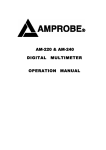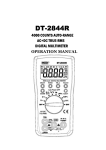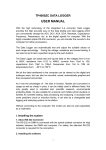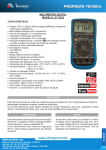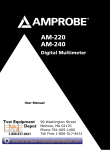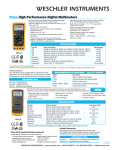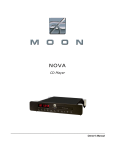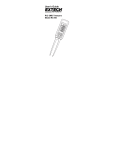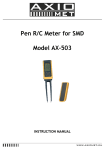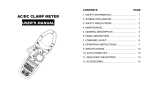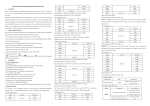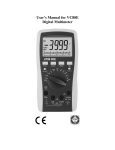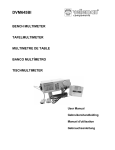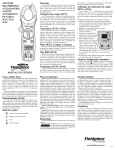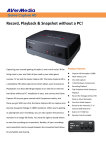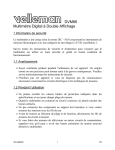Download User Manual
Transcript
DT-6930 3 3/4 DIGITAL TRUE-RMS AC/DC CLAMP MULTIMETER OPERATION MANUAL 1. ATIONSAFETY INFORM SAFETY SYMBOLS Warning! Dangerous Voltage (Risk of electric shock). Caution! Refer to the user’s manual before using this Meter. Double Insulation (Protection Class Ⅱ). Alternating Current (AC). Direct Current (DC). Either DC or AC. Ground (maximum permitted voltage between terminal and ground). The symbol indicating separate collection for electrical and electronic equipment. The RESPONSIBLE BODY shall be made aware that, if the instrument is used in a manner not specified by the manufacturer, the protection provided by the instrument may be impaired. The finger or any part of your body shall not be beyond the barrier of the test probe when measuring. Individual protective equipment must be used if HAZARDOUS LIVE parts in the installation where measurement is to be carried out could be ACCESSIBLE. Not to use the CURRENT SENSOR if the wear indicator in the JAW OPENING is visible. The following safety information must be observed to insure maximum personal safety during the operation at this meter. 1.1 Do not operate the meter if the body of meter or the test lead look broken. 1.2 Check the main function dial and make sure it is at the correct position before each measurement. 1.3 Do not perform resistance, capacitance, temperature, diode and continuity test on a live power system. 1.4 Do not apply voltage between the test terminals and test terminal to ground that exceed the maximum limit record in this manual. 1.5 Exercise extreme caution when measuring live system with voltage greater than 60V DC or 30V AC. 1.6 Keep the fingers after the protection ring when measuring through the clamp. 1.7 Change the battery when the “ ” symbol appears to avoid incorrect data. 1.8 Use the DMM indoor, altitude up to 2000m and temperature 5°C to 40°C. Maximum relative humidity 80% for temperatures up to 31°C, decreasing linearly to 50% relative humidity at 40°C. 1.9 In locations subject to radio frequency interference, the product may malfunction and it resets automatically when leaving this environment. 2. SPECIFICATIONS 2.1 GENERAL SPECIFICATIONS Display: 3 3/4 digits LCD with a max. reading of 4000. 1 Range control: Auto range & Manual range control Polarity: Automatic negative polarity indication. Zero adjustment: Automatic. Overrange indication: The “OL” or “-OL” display. Low battery indication: Display " " sign. Data hold: Display “ ” sign. Relative measurement: Display “△” sign. Clamp opening size: 32mm. Auto Power Off: When measurement exceeds 10 minutes without switching mode and pressing key, the meter will switch to standby mode. Press any key to exit standby mode. When start the system, press and hold any key to disable auto power off. Safety standards: EMC/LVD. CAT Ⅲ 600V. The meter is up to the standards of IEC1010 Double Insulation,Pollution Degree 2, Overvoltage Category Ⅲ. Operating environment: Temperature 32 to104°F (0°C to 40°C), Humidity ≤ 80% RH. Storage environment: Temperature -4 to140°F (-20°C to 60°C), Humidity ≤ 90% RH. Power supply: 9V battery. Dimension: 215(H) x 84(W) x 45(D) mm Weight: Approx. 335g (including battery). 2.2 ELECTRICAL SPECIFICATIONS Accuracies are ± ( % of reading + number in last digit ) at 23 ± 5°C , ≤75% RH. 2.2.1 DC Voltage Range Accuracy Resolution 40mV ± ( 0.8%+3 ) 0.01mV 400mV 0.1mV ± ( 0.5%+2 ) 4V 1mV 40V 10mV 400V 100mV 600V ± ( 0.8%+3 ) 1V Overload protection: 600V DC or AC rms Impedance: 10MΩ,More than 100MΩ on 40/400mV range 2.2.2 AC Voltage Range Accuracy 40mV Resolution 0.01mV 2 ± ( 1.5%+3 ) 400mV 0.1mV 4V 1mV ± ( 1.0%+2 ) 40V 10mV 400V 100mV 600V ± ( 1.5%+3 ) 1V AC True RMS Frequency: 40~1kHz Overload protection: 600V DC or AC rms Impedance: 10MΩ,More than 100MΩ on 40/400mV range 2.2.3 DC Current Range Accuracy Resolution 400A ± ( 1.5%+5 ) 0.1A 1000A ± ( 2.0%+10 ) 1A Overload protection: 1000A DC or AC rms 2.2.4 AC Current Range Accuracy Resolution 400A ± ( 2.0%+5 ) 0.1A 1000A ± ( 2.5%+10 ) 1A AC True RMS Frequency: 40~100Hz Overload protection: 1000A DC or AC rms 2.2.5 Resistance Range Accuracy Resolution 400Ω 0.1Ω 4kΩ 1Ω ± ( 1.0%+2 ) 40kΩ 10Ω 400kΩ 100Ω 4MΩ 1kΩ 40MΩ ± ( 2.0%+3 ) 10kΩ Overload protection: 250V DC or AC rms 2.2.6 Capacitance Range Accuracy Resolution 40nF ± ( 3.0%+10 ) 10pF ± ( 2.5%+5 ) 400nF 100pF 4µF 1nF 40µF ± ( 5.0%+10 ) 10nF ± ( 20.0%+20 ) 400µF 100nF 4000µF 1µF Overload protection: 250V DC or AC rms 2.2.7 Diode and Audible continuity test Range Description Test condition 3 Display read Forward DC current approximately approx. 0.4mA forward voltage Reversed DC voltage of diode approx. 2.8V Built-in buzzer Open circuit voltage sounds if approx. 0.5V resistance is less than 100Ω Overload protection: 250V DC or AC rms 2.2.8 Frequency Range Accuracy Resolution 10Hz 0.01Hz 100Hz 0.1Hz 1000Hz 1Hz ± ( 0.1%+5 ) 10kHz 10Hz 100kHz 100Hz 1000kHz 1kHz 10MHz 10kHz Sensitivity: sine wave 0.6V rms (10MHz: 1.5V rms) Overload protection: 250V DC or AC rms 2.2.9 Duty cycle 0.1%~99.9%: ± ( 2.0%+2 ) Frequency lower than 10kHz Sensitivity: sine wave 0.6V rms Overload protection: 250V DC or AC rms 2.2.10 Frequency (Clamp-On) 25Hz~400Hz: ± ( 0.1%+5 ) Sensitivity: 3A rms Overload protection: 1000A DC or AC rms 2.2.11 Temperature Range Accuracy Resolution -50~150℃ ± (3℃+1) ℃/℉ -58~302℉ ± (5℉+2) 1℃/1℉ 150~700℃ ± (3%+1) 302~1292℉ ± (3%+2) NiCr-NiSi sensor Overload protection: 250V DC or AC rms 3. OPERATION 3.1 DC and AC Voltage Measurement 4 1) Connect the black test lead to "COM" socket and red test lead to the "VΩHz" socket. 2) Set the selector switch to desired “mV ” or “V ” position. 3) Press “SELECT” key to choose “DC” or “AC” measurement. 4) Measure the voltage by touch the test lead tips to the test circuit where the value of voltage is needed. 5) Read the result from the LCD panel. 6) On AC range, press “Hz/DUTY” key to measurement frequency or duty cycle. 3.2 DC Current Measurement 1) Set the selector switch to desired “400A ” or “1000A ” position. 2) Press “SELECT” key to choose “DC” measurement. 3) Zero the reading by pressing “REL△(DCA ZERO ADJ.)” key for a reading of zero on the display. 4) Disconnect the test leads from the Meter. 5) Clamp the Jaws around the one conductor to be measured. Center the conductor within the Jaw using the Centering Marks as guides. 6) Read the result from the LCD panel. The arrow in the Jaw indicates the direction of positive current flow (positive to negative). 3.3 AC Current Measurement 1) Set the selector switch to desired “400A ” or “1000A ” position. 2) Press “SELECT” key to choose “AC” measurement. 3) Disconnect the test leads from the Meter. 4) Clamp the Jaws around the one conductor to be measured. Center the conductor within the Jaw using the Centering Marks as guides. 5) Read the result from the LCD panel. 3.4 Resistance Measurement 1) Connect the black test lead to "COM" socket and red test lead to the "VΩHz" socket. ” position. 2) Set the selector switch to desired “ 3) Press “SELECT” key to choose Resistance measurement. 4) Connect tip of the test leads to the points where the value of the resistance is needed. 5) Read the result from the LCD panel. Note: When take resistance value from a circuit system, make sure the power is cut off and all capacitors need to be discharged. 3.5 Capacitance Measurement 1) Connect the black test lead to "COM" socket and red test lead to the "VΩHz" socket. ” position. 2) Set the selector switch to desired “ 3) Press “SELECT” key to choose Capacitance measurement. 4) Connect tip of the test leads to the points where the value of the capacitance is needed. 5) Read the result from the LCD panel. Note: 5 a) Before testing, discharge the capacitor by shorting its leads together. Use caution in handing capacitors because they may have a charge on them of considerable power before discharging. b) Before testing, press “REL△(DCA ZERO ADJ.)” key to eliminate the zero error. c) When testing 4000µF capacitor, note that there will be approx. 30 seconds time lag. 3.6 Diode and Audible continuity Test 1) Connect the black test lead to "COM" socket and red test lead to the "VΩHz" socket. 2) Set the selector switch to desired “ ” position. 3) Press “SELECT” key to choose Diode or Audible continuity measurement. 4) Connect the test leads across the diode under measurement, display shows the approx. forward voltage of this diode. 5) Connect the test leads to two point of circuit, if the resistance is lower than approx. 100Ω, the buzzer sounds. Note: Make sure the power is cut off and all capacitors need to be discharged under this measurement. 3.7 Frequency and Duty cycle measurement 1) Connect the black test lead to "COM" socket and red test lead to the "VΩHz" socket. 2) Set the selector switch to desired “Hz” position. 3) Press “Hz/DUTY” key to choose Frequency or Duty cycle measurement. 4) Connect the probe across the source or load under measurement. 5) Read the result from the LCD panel. 3.8 Frequency (Clamp-On) measurement 1) Set the selector switch to desired “Hz(Clamp-On)” position. 2) Disconnect the test leads from the Meter. 3) Clamp the Jaws around the one conductor to be measured. Center the conductor within the Jaw using the Centering Marks as guides. 4) Read the result from the LCD panel. 3.9 Temperature Measurement 1) Connect the black test lead of the sensor to "COM" socket and red test lead to the "VΩHz" socket. 2) Set the selector switch to desired “℃/℉” position. 3) Press “SELECT” key to choose “℃” or “℉”measurement. 4) Put the sensor probe into the temperature field under measurement. 5) Read the result from the LCD panel. 3.10 Data Hold On any range, press the “D.HOLD” key to lock display value, and the “ ” sign will appear on the display, press it again to exit. 3.11 MAX/MIN Hold Press the “MIN/MAX” key to lock MAX or MIN value, and the “MAX” or “MIN” sign will appear on the display, press it over 2 seconds to exit. 3.12 Back Light 6 On any range, press the “D.HOLD” key over 2 seconds to light the back light, press it again for more than 2 seconds to wink the light. The light can wink automatically after 10 seconds too. 3.13 Relative measurement Press the “REL△” key, you can measure the relative value and “△” sign will appears on the display, the auto range mode be changed to manual range mode. Press it again to exit relative measurement and “△” sign disappears, but you can not go back to auto range mode. This function can be used to zero the reading on DCA range. This function is non effective on Hz/DUTY measurement. 4. Battery replacement 1) When the battery voltage drop below proper operation range, the “ ” symbol will appear on the LCD display and the battery need to changed. 2) Before changing the battery, set the selector switch to “OFF” position. Open the cover of the battery cabinet by a screwdriver. 3) Replace the old battery with the same type battery. 4) Close the battery cabinet cover and fasten the screw. Caution: Dispose the used batteries according to the rules, which are defined by each community. 5. MAINTENANCE 1) Before open the battery door, disconnect both test lead and never uses the meter before the battery door is closed. 2) To avoid contamination or static damage, do not touch the circuit board without proper static protection. 3) If the meter is not going to be used for a long time, take out the battery and do not store the meter in high temperature or high humidity environment. 4) When take current measurement, keep the cable at the center of the clamp will get more accurate test result. 5) Repairs or servicing not covered in this manual should only by qualified personal. 6) Periodically wipe the case with a dry cloth and detergent. Do not use abrasives or solvents on the meter. 7








